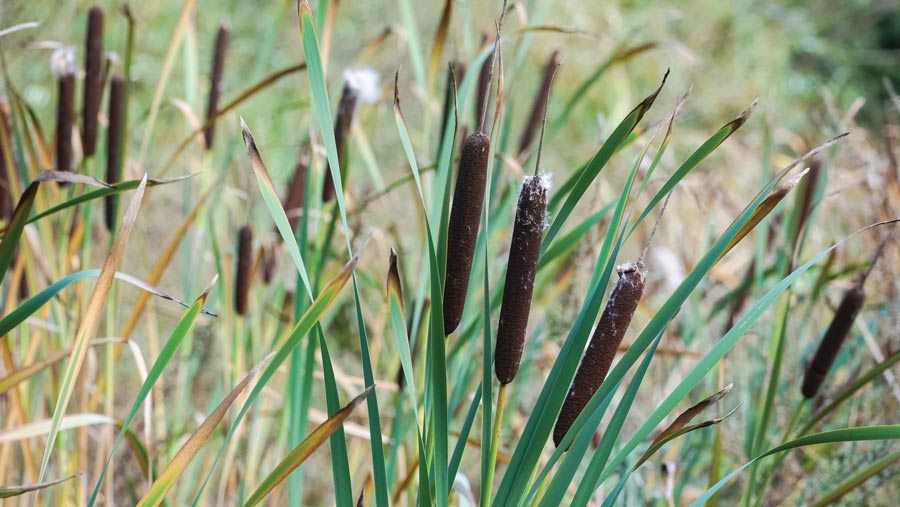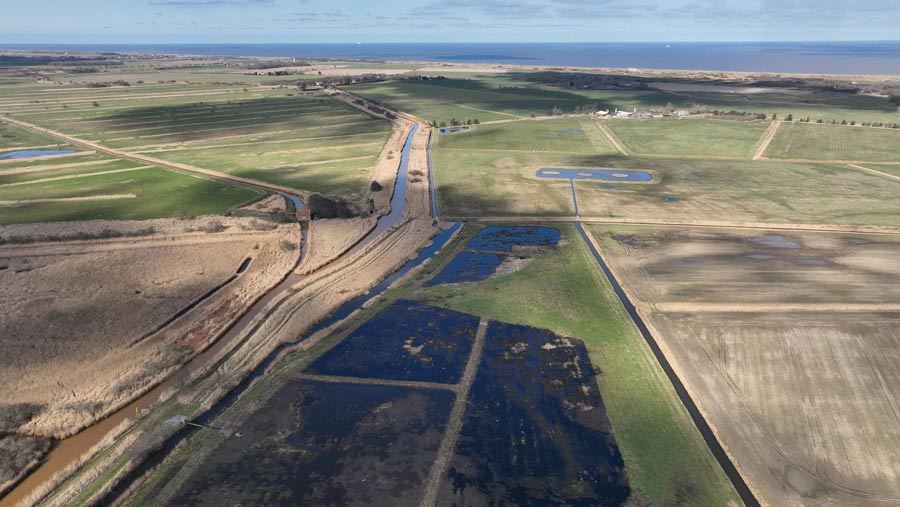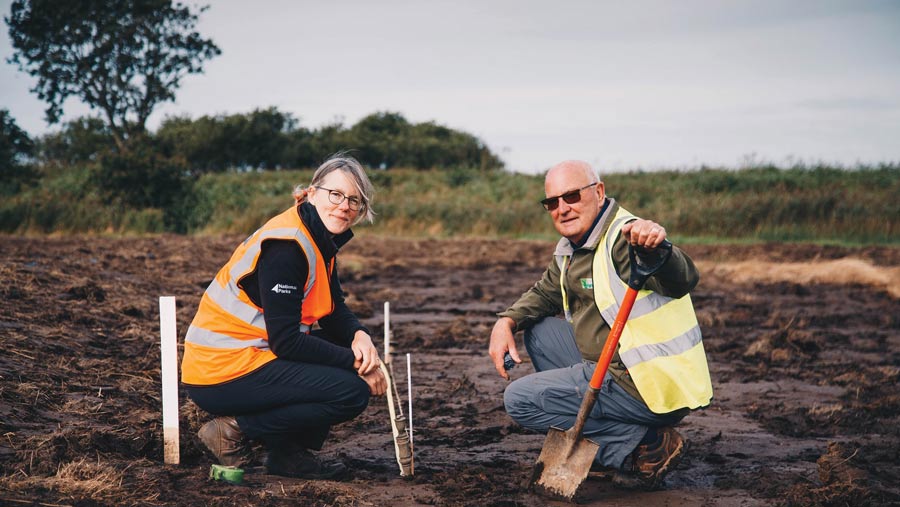Are wetland crops the future on lowland peat?
 Bulrush © Marcin Rogozinski/Adobe Stock
Bulrush © Marcin Rogozinski/Adobe Stock England’s lowland peat soils are some of the most valuable when it comes to food production, but they also contribute to greenhouse gas emissions.
Draining peatland soils has allowed them to be used to grow a wide array of fresh vegetables, salads, grains, meat and dairy products over many centuries.
However, it has also led to an ongoing cycle of peat oxidation, soil degradation and subsidence.
This results in carbon dioxide being released into the atmosphere and puts the long-term future of such soils under threat.
According to the recent Lowland Agricultural Peat Task Force Report – chaired by farmer and chairman of the Association of Drainage Authorities Robert Caudwell – greenhouse gas emissions from lowland agricultural peatlands account for about 3% of England’s overall total emissions.
The taskforce report concludes that for climate change reasons and to ensure that our peat soils can continue to provide for future generations, farmers must be helped to transition to more sustainable management practices.
See also: How fenland farmers are cutting greenhouse gases from peat
What does the report recommend?
The report makes 14 recommendations to ensure lowland peat soils can be managed more sustainably.
Some of these can be delivered in the short term, while others will need further development over the mid- to long term.
Key to the future, it suggests, is retaining more water in lowland peat landscapes because this will slow the release of carbon.
However, it stresses this does not mean that water levels can, or should, be raised in all peatland settings. Nor is it advocating measures which will halt the productive use of the land.
“New measures for peat can only be deployed if farm businesses are to remain viable,” it says, adding: “No farmer on peat soil should be left financially worse off for better managing our carbon stores.”
Raising water levels on peatland would need to be done in a managed way to maintain the profitable use of the land, with social and economic considerations balanced against environmental ones, says the report.
“New ways of farming on peat must be practically and economically viable, and they must not drive food production overseas, nor increase emissions arising from food production.”
The report details how improving water-level management will require significant investment in water storage and control systems. Alongside changes in water levels is the need to embrace wetter modes of farming on peat.
So how can lowland peat be farmed more sustainably?
The task force recommends that Defra should use schemes such as the Sustainable Farming Incentive (SFI) and Countryside Stewardship (CS) to incentivise management practices that would help farmers preserve peat and reduce emissions as part of their existing farming regimes.
Payments could be based on a sliding payment scale depending on the height to which the water table is restored and to account for differences in topography, soil and climate.
It suggests that CS could also be used as a vehicle to help pay for the capital infrastructure that will be needed to raise water levels.
Meanwhile, Peat Sensitive Farming Advisers (PSFAs) could be introduced to build trust and understanding in new wet farming techniques.
There is also an ambition for farmers, particularly those on marginal and low-lying farmland, to transition to a system called paludiculture.

Wetland farming site at Horsey © Broads Authority
What is paludiculture?
This is the name given to the growing of commercial crops on rewetted peat.
Eighty-eight native UK wetland species have been identified with potential for energy, food, fodder, medicinal use and raw material provision.
The two crops getting the most attention are typha (bulrush), which can be used to make insulation fibreboard, and farmed sphagnum moss, which has the potential to replace peat as a growing media.
Is it a commercial option now?
Not yet. A subgroup of the taskforce has set out a roadmap for making the wide-scale adoption of paludiculture a commercial reality in England over a 10-year timescale, starting this year.
However, the report’s authors acknowledge that it is unlikely to be widely practised by 2033.
One of the priorities will be developing the business cases for different crop and product combinations, so farmers are reassured that switching to wetter forms of farming is financially viable.
This will involve establishing field-scale experimental trials for farmed spagnhum and typha within the next two or three years, so information can start to be collected about establishment methods, crop management, pests, diseases, labour requirements, how to harvest it and ultimately, the economics.
Along the way there will be practical challenges to address, such as whether existing machinery can be adapted to cope with the new crops and conditions.
Another crucial part of the jigsaw is establishing how farmers might be able to stack payments for the wider benefits of wetter farming, by selling nutrient neutrality, biodiversity net gain and carbon units from peatland.
Other crops that may be suitable for paludiculture
- Food: bilberry, celery, cranberry, meat, nettle, sedge grains, sweet grass grains, watercress and water pepper
- Herbal remedies, medicines and biomedical: bilberry, bog myrtle, cranberry, comfrey, hemp agrimony, lady’s smock, meadowsweet, round leaved sundew and sphagnum moss
- Flavourings: bilberry, bog myrtle, meadowsweet, round leaved sundew, water mint and wild celery
- Construction materials: bulrush and reed (for fibreboards), bulrush (for lightweight aggregate) and reed (roofing thatch)
- Furniture and decorative homewares: alder, rush and willow
- Bioenergy: bulrush, reed and willow
- Growing media: sphagnum moss
- Fabrics: bulrush (as a down replacement) and nettle
- Industrial chemicals: reed (silica) and sphagnum moss
Reception for recommendations?
The NFU has welcomed recognition of the need to balance soil protection with sustainable food production, in addition to the taskforce’s acknowledgement of the complexities of re-wetting of lowland peat to reduce emissions.
“We are pleased a range of mechanisms, from Environmental Land Management schemes through to technical advice and capital grants, will be made available to help improve lowland peatland management,” said a spokesman.
However, it has stressed that it is crucial that farmers are included in any local decisions on lowland peat management, especially those that involve raising water levels.
The Country Land and Business Association says the report emphasises that a “paradigm shift in farming on peat” must occur, but it is clear there is not yet enough knowledge available for an immediate transition.
Meanwhile, Defra has agreed to all 14 of the taskforce’s recommendations.
Case study one: Rindle wetter farming trial
Lancashire Wildlife Trust is leading the charge in terms of research on how to combine reductions in carbon emissions on lowland peat with financially viable food production.
The Trust started its paludiculture journey four years ago when it established the Winmarleigh carbon farm by rewetting 2ha of lowland peat and then planting sphagnum moss to start the process of re-vegetating the peat.
This led to an 86% drop in greenhouse gas (GHG) emissions in the space of one winter, when compared with a neighbouring plot of grazed pasture.
While they found farmers were interested in the work, their feedback was that they were unlikely to get involved on their own farms because of the need to keep producing food and make a living.
The team is now trialling growing celery and blueberries using paludiculture techniques.
Mike Longden, senior project officer in Lancashire Wildlife Trust’s Peatlands Team, says the celery trial is the first time that anyone in the UK has trialled farming traditional food crops on land with a higher water table.
Now in its second year, the team is experimenting with how the crop performs if the water table is kept at either 50cm, 30cm or 10cm below surface level.
Traditionally, the water table would be around 1m below surface level.
During the first year, no fertilisers or pesticides were used to enable the team to collect baseline data about GHG emissions.
This meant the crop just failed to reach the point of harvest.
However, this year the crop is being managed with similar inputs to those for a commercial crop on unwetted peat and, so far, is looking very promising.
“What we’ve tried to do is farm it as closely as possible to how a farmer would, including using the same machines,” says Mike.
“The difference is our trial has the crop grown in either ‘wet’, ‘wetter’ and then ‘completely wet’ conditions, so we can identify the sweet spot where we get the best crop and the lowest greenhouse gas emissions.
“At the moment, we are thinking there might be a slight drop in yields, but are exploring how farmers might be compensated for this because of the carbon savings they would be making.”
The objective is to gather enough evidence to prove to farmers there is a business case to try growing crops in a different way, or experiment with new crops.
“There isn’t a ‘one answer fits all’ – it has to be a mosaic of land uses, with the correct crops, in the correct field with the correct hydrology.
A trial crop of 800 blueberry plants was planted earlier this year, from which the team hopes to take a harvest in 2025.
Different species have been planted to see which perform best under wet conditions and they are also experimenting with growing sphagnum moss as a companion crop.
The team is also lead partner in a £400,000 research project funded through the government’s Paludiculture Exploration Fund which will see a 5ha crop of typha (bulrush) planted next year.
Farmer Steve Denneny, who will be growing the crop, said: “I’m excited to be part of this trial to find a new way to manage my land that is more environmentally friendly, but will also provide a commercially viable crop.”
Case study two: Reed trials in the Broads

Andrea Kelly © Broads Authority
The Broads Authority in Norfolk established its first wetland demonstration site in 2021 to see how crops suitable for paludiculture perform in a field setting.
The crops are being grown in a series of “compartments” located on the lowest parts of a 3ha field, which has been made available by the Horsey Estate.
The land was previously down to grass and is typical of the Broads landscape, where all the peatland remains under pasture.
Andrea Kelly, environment policy adviser for the Broads Authority, which is leading the trial, says the initial focus of the project has been on the production of reed, given that is a traditional feature of the Broads.
There are reed cutters already operating in the area and an established market for the end product, which is used as thatching material.
“We import about 97% of the reed we need for thatch, and it is estimated we need about 5,000ha of additional reed to satisfy demand from all the thatched properties in the UK,” says Andrea.
“Imported reed comes from China and eastern Europe, the supply is less reliable than it has been and often it sweats in transit. Everyone who owns a thatched house will tell you they would much rather have local thatch.”
With minimal intervention, reed typically takes around three to four years to get to the point of harvest and from then on will produce an annual crop.
The other crops being trialled are more “futuristic”, as the end markets are less developed, but include typha, miscanthus and reed canary grass – the latter being a high-protein fodder crop or energy biomass, says Andrea.
The team has decided that sphagnum moss is probably not appropriate for large areas of the Broads because most of the land has never been ploughed and harvesting moss requires flat land.
To help explore markets for plant-based fibres, the Broads Peat Partnership (a partnership of stakeholders operating within the Broads Catchment and Norfolk Fens) has just been awarded £395,000 through the Paludiculture Exploration Fund for a Fibre Broads project.
This initiative will identify areas in the Broads most suited to wetland crops and explore the potential of crops such as typha to produce unbonded fibreboard, which can be used in the construction industry.
Other key projects
Fens
Fenland Soil has secured £450,000 through the Paludiculture Exploration Fund (PEF) to extend its existing landscape mapping work – identifying peatland suitable for change of land use to paludiculture – to four new Internal Drainage Boards (IDBs).
It will also be establishing a commercial-scale, paludiculture trial.
Meanwhile, the Peatland Progress project has secured support from the National Lottery Heritage Fund to support a five-year trial of wet farming techniques across 120ha in the Cambridgeshire Fens. This will be the first farm-scale trial in the UK.
Somerset Levels
Coates English Willow has been awarded money through the PEF to look at the potential of growing low-impact willow on the peat on West Sedgemoor.
The project will research and develop techniques for more efficient planting, lower herbicide use, and improved harvesting practices.
In addition, the Farming and Wildlife Advisory Group Southwest has been given funding to explore different land use options which could provide an income stream for owners of the lowest-lying fields.
